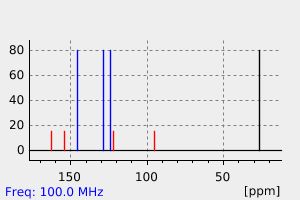4-aza-3-chloro-3-methyl-1(3H)-isobenzofuranone 4-oxide | 38070-70-1
中文名称
——
中文别名
——
英文名称
4-aza-3-chloro-3-methyl-1(3H)-isobenzofuranone 4-oxide
英文别名
7-Chloro-7-methyl-1-oxidofuro[3,4-b]pyridin-1-ium-5-one
CAS
38070-70-1
化学式
C8H6ClNO3
mdl
——
分子量
199.594
InChiKey
NFARSJDPMHJTJT-UHFFFAOYSA-N
BEILSTEIN
——
EINECS
——
-
物化性质
-
计算性质
-
ADMET
-
安全信息
-
SDS
-
制备方法与用途
-
上下游信息
-
文献信息
-
表征谱图
-
同类化合物
-
相关功能分类
-
相关结构分类
物化性质
-
沸点:498.3±45.0 °C(Predicted)
-
密度:1.53±0.1 g/cm3(Predicted)
计算性质
-
辛醇/水分配系数(LogP):0.2
-
重原子数:13
-
可旋转键数:0
-
环数:2.0
-
sp3杂化的碳原子比例:0.25
-
拓扑面积:51.8
-
氢给体数:0
-
氢受体数:3
上下游信息
-
上游原料
中文名称 英文名称 CAS号 化学式 分子量 —— 3-acetoxy-4-aza-3-methyl-1(3H)-isobenzofuranone 4-oxide 111068-01-0 C10H9NO5 223.185 -
下游产品
中文名称 英文名称 CAS号 化学式 分子量 —— 4-aza-3-chloro-3-methyl-1(3H)-isobenzofuranone 38070-71-2 C8H6ClNO2 183.594 —— 4-aza-3-methoxy-3-methyl-1(3H)-isobenzofuranone 111068-05-4 C9H9NO3 179.175
反应信息
-
作为反应物:描述:4-aza-3-chloro-3-methyl-1(3H)-isobenzofuranone 4-oxide 在 三氯化磷 作用下, 以 乙酸乙酯 、 N,N-二甲基甲酰胺 为溶剂, 反应 2.17h, 生成 4-aza-3-methoxy-3-methyl-1(3H)-isobenzofuranone参考文献:名称:Reinvestigation of the Reaction of Nicotinic Acid 1-Oxide with Acetic Anhydride摘要:DOI:10.3987/r-1987-05-1263
-
作为产物:描述:氧烟酸 在 盐酸 、 氯化亚砜 、 N,N-二甲基甲酰胺 作用下, 反应 12.0h, 生成 4-aza-3-chloro-3-methyl-1(3H)-isobenzofuranone 4-oxide参考文献:名称:Reinvestigation of the Reaction of Nicotinic Acid 1-Oxide with Acetic Anhydride摘要:DOI:10.3987/r-1987-05-1263
文献信息
-
Synthesis and stability of 2-methyl-2,4-diaza- and 2-methyl-2,5-diaza-indene (2-methyl-pyrrolo[3,4-b]pyridine and -pyrrolo[3,4-c]pyridine)作者:W. L. F. Armarego、Beverly A. Milloy、S. C. SharmaDOI:10.1039/p19720002485日期:——2-Methyl-2,4-diaza-(2) and 2-methyl-2,5-diaza-(3) indenes have been prepared by oxidation of 2,3-dihydro-2-methyl-1H-2,4-diaza-(10) and 2,3-dihydro-2-methyl-1 H-2,5- diaza-(14) indene, respectively with 2,3-dichloro-5,6-dicyano-1,4-benzoquinone., They are more stable than 2-methyl-2-azaindene (1) in dilute acid, as neutral species in aqueous solution, and to aerial oxidation, and form stable picrates通过氧化2,3-二氢-2-甲基-1 H -2,4制备了2-甲基-2,4-二氮杂-(2)和2-甲基-2,5-二氮杂-(3)茚。-重氮-(10)和2,3-二氢-2-甲基-1 H-2,5-二氮杂-(14)茚分别与2,3-二氯-5,6-二氰基-1,4-苯醌。在稀释中比2-甲基-2-氮杂茚(1)更稳定酸,作为水溶液中的中性物质,并向空中氧化,并形成稳定的苦味酸盐。两种二氮杂茚烯(2)和(3)是相对较强的碱。尽管质子化主要发生在N-4和N-5上,以形成共振稳定的阳离子,但氘在稀酸中交换H-1和H-3的难易程度(前者更大)表明,一些像在2-甲基-2-氮杂茚中一样,质子化也分别在C-1和C-3上发生。三种氮杂茚(1)–(3)中H-1和H-3的nmr化学位移表明它们是芳族体系。
-
Nagano, Hiroyuki; Nawata, Yoshiharu; Hamana, Masatomo, Chemical and pharmaceutical bulletin, 1987, vol. 35, # 10, p. 4068 - 4077作者:Nagano, Hiroyuki、Nawata, Yoshiharu、Hamana, MasatomoDOI:——日期:——
-
NAGANO, HIROYUKI;NAWATA, YOSHIHARU;HAMANA, MASATOMO, CHEM. AND PHARM. BULL., 35,(1987) N 10, 4068-4077作者:NAGANO, HIROYUKI、NAWATA, YOSHIHARU、HAMANA, MASATOMODOI:——日期:——
-
NAGANO, HIROYUKI;HAMANA, MASATOMO;NAWATA, YOSHIHARU, HETEROCYCLES, 26,(1987) N 5, 1263-1270作者:NAGANO, HIROYUKI、HAMANA, MASATOMO、NAWATA, YOSHIHARUDOI:——日期:——
-
VALTER R. EH.; BATSE A. EH.; PETROVA M. V.; KAMPARE R. B., IZV. AN LATVSSR. CEP. XIM.,(1987) N 3, 360-361作者:VALTER R. EH.、 BATSE A. EH.、 PETROVA M. V.、 KAMPARE R. B.DOI:——日期:——
表征谱图
-
氢谱1HNMR
-
质谱MS
-
碳谱13CNMR
-
红外IR
-
拉曼Raman
-
峰位数据
-
峰位匹配
-
表征信息
同类化合物
(S)-氨氯地平-d4
(R,S)-可替宁N-氧化物-甲基-d3
(R)-(+)-2,2'',6,6''-四甲氧基-4,4''-双(二苯基膦基)-3,3''-联吡啶(1,5-环辛二烯)铑(I)四氟硼酸盐
(R)-N'-亚硝基尼古丁
(R)-DRF053二盐酸盐
(5E)-5-[(2,5-二甲基-1-吡啶-3-基-吡咯-3-基)亚甲基]-2-亚磺酰基-1,3-噻唑烷-4-酮
(5-溴-3-吡啶基)[4-(1-吡咯烷基)-1-哌啶基]甲酮
(5-氨基-6-氰基-7-甲基[1,2]噻唑并[4,5-b]吡啶-3-甲酰胺)
(2S,2'S)-(-)-[N,N'-双(2-吡啶基甲基]-2,2'-联吡咯烷双(乙腈)铁(II)六氟锑酸盐
(2S)-2-[[[9-丙-2-基-6-[(4-吡啶-2-基苯基)甲基氨基]嘌呤-2-基]氨基]丁-1-醇
(2R,2''R)-(+)-[N,N''-双(2-吡啶基甲基)]-2,2''-联吡咯烷四盐酸盐
(1'R,2'S)-尼古丁1,1'-Di-N-氧化物
黄色素-37
麦斯明-D4
麦司明
麝香吡啶
鲁非罗尼
鲁卡他胺
高氯酸N-甲基甲基吡啶正离子
高氯酸,吡啶
高奎宁酸
马来酸溴苯那敏
马来酸氯苯那敏-D6
马来酸左氨氯地平
顺式-双(异硫氰基)(2,2'-联吡啶基-4,4'-二羧基)(4,4'-二-壬基-2'-联吡啶基)钌(II)
顺式-二氯二(4-氯吡啶)铂
顺式-二(2,2'-联吡啶)二氯铬氯化物
顺式-1-(4-甲氧基苄基)-3-羟基-5-(3-吡啶)-2-吡咯烷酮
顺-双(2,2-二吡啶)二氯化钌(II) 水合物
顺-双(2,2'-二吡啶基)二氯化钌(II)二水合物
顺-二氯二(吡啶)铂(II)
顺-二(2,2'-联吡啶)二氯化钌(II)二水合物
韦德伊斯试剂
非那吡啶
非洛地平杂质C
非洛地平
非戈替尼
非布索坦杂质66
非尼拉朵
非尼拉敏
雷索替丁
阿雷地平
阿瑞洛莫
阿扎那韦中间体
阿培利司N-6
阿伐曲波帕杂质40
间硝苯地平
间-硝苯地平
镉,二碘四(4-甲基吡啶)-
锌,二溴二[4-吡啶羧硫代酸(2-吡啶基亚甲基)酰肼]-







